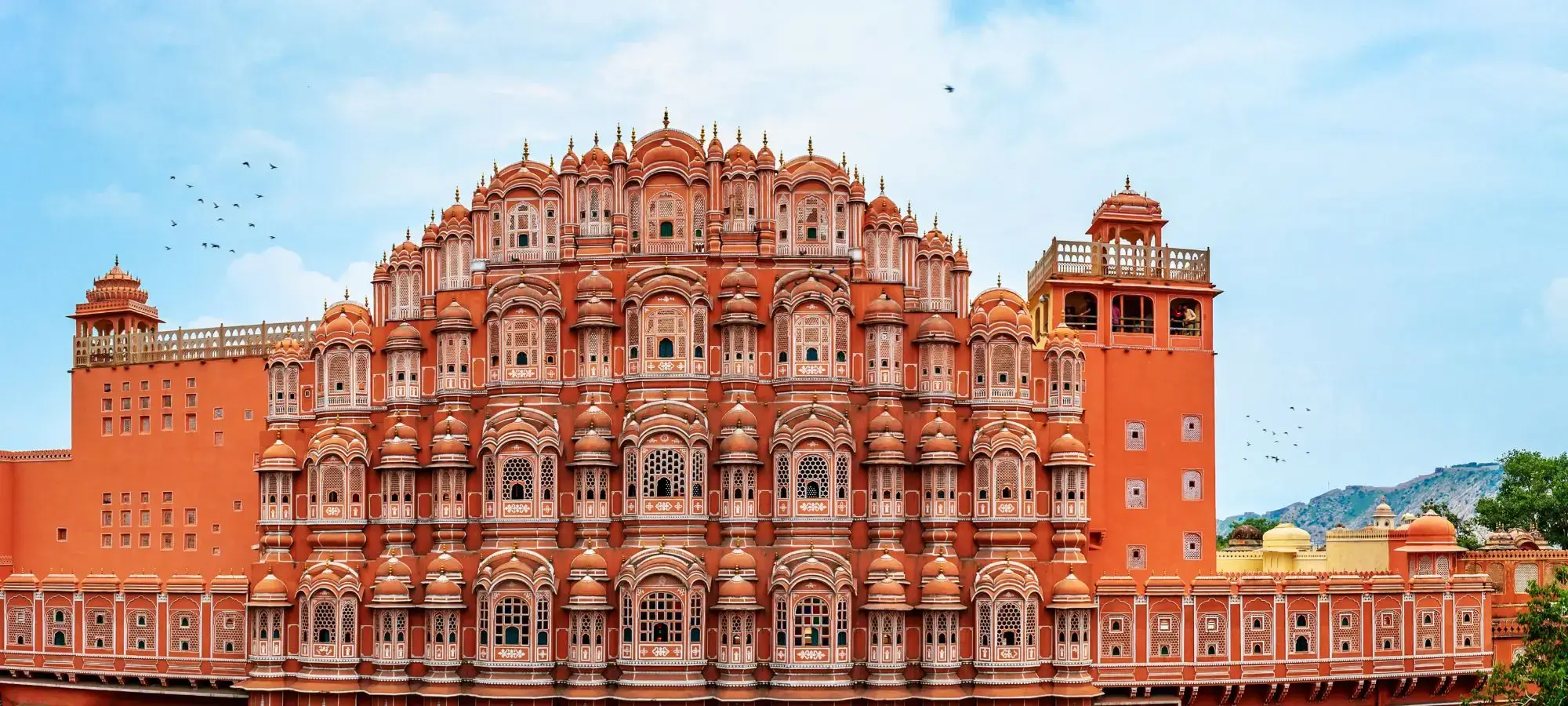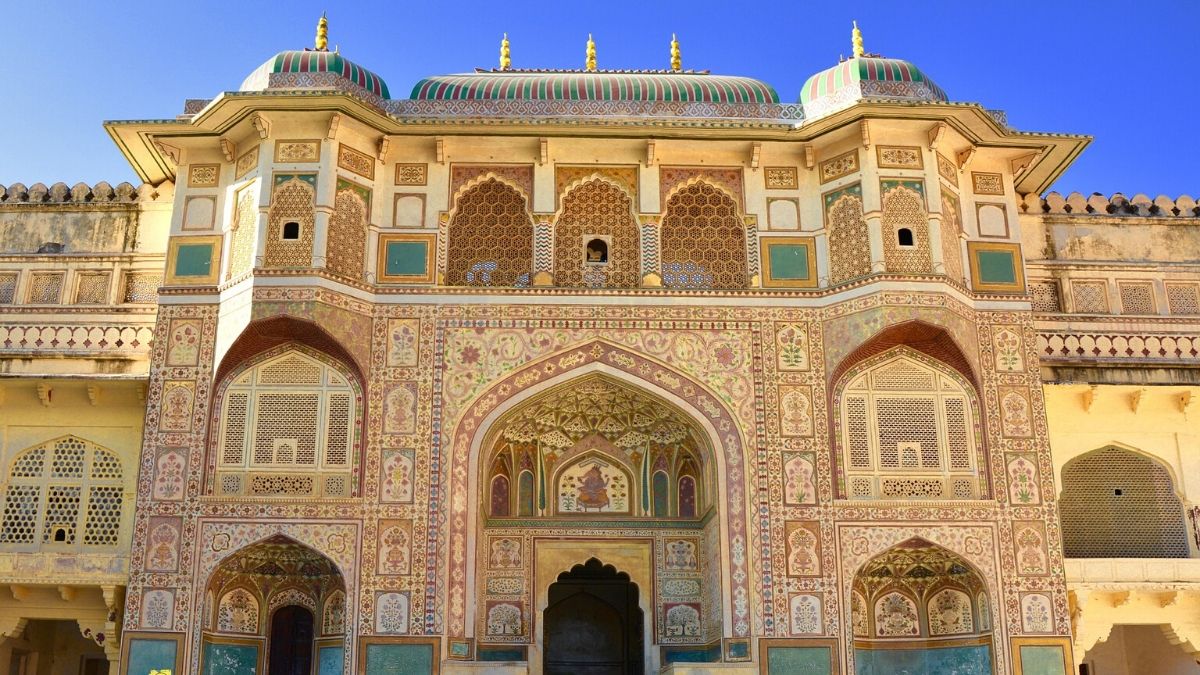Jaipur – The Pink City
Jaipur, affectionately known as the Pink City, is a harmonious blend of royal heritage and architectural brilliance. Established in 1727 by Maharaja Sawai Jai Singh II, the city boasts a grid-like layout inspired by Vastu Shastra principles. Wander through its bustling bazaars, marvel at the intricate designs of Hawa Mahal, and explore the grandeur of Amber Fort. From the astronomical wonders of Jantar Mantar to the spiritual serenity of Govind Ji Temple, Jaipur offers a captivating journey through history and culture.

Planned by young Bengali architect, Vidyadhar Bhattacharya, Jaipur was built by Maharaja Sawai Jai Singh II in 1727 A.D. Laid in a grid system, with straight avenues, roads, streets, lanes criss cross the city with rows of shops on either side of main bazaars arranged in nine rectangular city sectors (Chowkris). The planning of the city followed the principles of “Shilpshastra”, an epochal treatise of Hindu architecture.
Displaying remarkable harmony, the heart of the Pink city still bears in its fairy tale palaces, rugged fortress perched on hills. The only planned city of it’s time, Jaipur is encircled by a formidable wall. Jaipur today is blend of tradition and modernity. Beautifully laid out gardens and parks intersperse the timeless appeal of its colourful marvellous heritage hotel, once residence of Maharajas transport you to the days of royalty of yore. Mingle with the people, let ambling camels pass you by. Make your trip to the Pink City a truly memorable one.Jaipur Tourist Attractions- Important
City Palace: in the heart of the old city is the former royal residence built in a blend of Rajasthani and Mughal style. The carved arches are supported by grey white marble columns ornate with floral motifs in god and coloured stones. The two carved elephants in marble guard the entrance.

The Palace:Houses a museum with a superb collection of Rajasthani costumes and armoury of Mughals and Rajputs including swords of different shapes and sizes with chased handles, some of them inlaid with enamel and embellished with jewels and encased in magnificent scabbards
The Palace also has an art gallery with an excellent collection of miniature paintings, carpets, royal paraphernalia and rare astronomical work in Arabic, Persian, Latin and Sanskrit, acquired by Sawai Jai Singh II to study astronomy in detail.
Jantar Mantar: A stone observatory largest of Jais Singhs five remarkable observatories. Its complex instruments whose settings and shapes are scientifically, designed, represent the high paints of medieval Indian astronomy. The most striking of these are the Ram Yantras used for gauging altitudes.
Hawa Mahal: Built in 1799 A.D the Hawa Mahal or Palace of Winds is a major Rajput landmark. This five-storey building along the main street of the old city is in pink splendour with semi octagonal and delicately honey combed sandstone windows. The monument was originally conceived with the aim of enabling ladies of the royal household to watch the everyday life and royal processions of the city.
Govind Ji Temple: The most popular spireless temple of Jaipur dedicated to Lord Krishna. It is located in the central pavilion of Jai Niwas garden to the North of Chandra Mahal. The image of the patron deity Govind Dev ji, originaly installed in a temple of Vrindavan, was reinstalled here by Sawai Jai Singh II as his family deity.
Swwargasul:The highest tower dominating the skyline on the western side of the tripolia Bazaar. It was built by Sawai Iswari Singh in 1749 A.D to commemorate a grand victory.
Ghat Ki Guni:Beautifully landscaped gardens, laid out in the 18th and 19th Century by kings and courtiers dot the narrow gorge in the south eastern corner of the walled city, along the road to Agra. Sisodia Rani garden has tiered multilevel gardens fountains, water channel and painted pavilions and suites of living rooms. Amongst others, Vidyadhar-ka-bagh is the best preserved one with shady trees, flowing water, an open pavilion. It was built by the planner of the city, Vidyadhar.
Amber: Former capital of the Kachchhwaha rulers of the old state of Dhundhar for seven centuries. Very little of early structures survive now.

Amber Palace and Shilpa Mata Temple: A beautifully complex palaces, halls, pavilions, gardens and temples built by Raja jai Singh over a period of about two centuries still stand in magnificent state. The Palace complex emerges dramatically from the placid waters of the Mootha Lake and is approachable only through steep path. Tourists often ride on elephant back to Singh Pal and the Jaleb chowk. Two flight stairs rise from one end of the chowk, one leading to Shila Mata temple and other to the palace complex. The image of the patron goddess, worshipped by thousands of devotees, was brought from Jessore in East Bengal by Raja Man Singh, to be installed here.
Sheetla Mata Fair:Every year Sheetla Mata Fair is held in March/April .The word ‘Sheetla’ is derived from Sheetal which means calm and composed. It is belief that if Sheetla Mata, the goddess of epidemics loses her temper then the area is expected to be affected by dangerous epidemics. The fair is organized to keep her mood cheerful and offerings of different type of fruits, sweets and cash is offered at her feet. A beautiful red stone placed inside the temple is an embodiment of the deity. People are supposed to take food only after visiting the sacred shrine of Sheetla Mata.The fair is held in Seel-Ki-Doongri village in Jaipur. It lasts for only 24 hours in which pilgrims visit to pay homage to Sheetla Mata.
Diwan-E-AmA spectacular pillared hall Diwan-e-Am and double storeyed painted gateway, Ganesh Pol dominate the front courtyard. An elegant tiny garden in Charbagh style beyond the corridors has Sukh Niwas to its right and Jas Mandir to its left. The latter combines the Mughal and the Rajput Architecture, seen in its beautiful interior with intricately carved jail screens, delicate mirrors, stucco work; painted and carved dadoes. The well-proportioned Mohan bari or Kesar Kyari in the centre of Mootha lake and Dilram Bagh at its north end and provides a spectacular view of the palace above
Elephant Ride: One of the highlights of a visit to the spectacular Amer Fort is the chance to ride an elephant up the hill to the main entrance. Elephants are decorated with traditional painted patterns and smoothly carry visitors up the steep slope to the fort. The Amer Fort elephant ride is a fantastic experience. Visitors has to arrive early for guarantee a ride and avoid disappointment.
Important Note: Please visit the Amer Fort early in the morning (much before 9:00 am), to guarantee a ride and avoid the queues. There are approximately 80 elephants, which carry up 900 visitors per day. Elephants are limited to five trips and carry only 2 passengers. During the peak tourist season most of the elephants have finished their quote of rides by 11:00 am. The elephant rides are in only one direction heading from the car park up to the main courtyard. Many visitors stand for a long time, under the intense sun waiting for a ride. It is strongly advised to arrive early!
